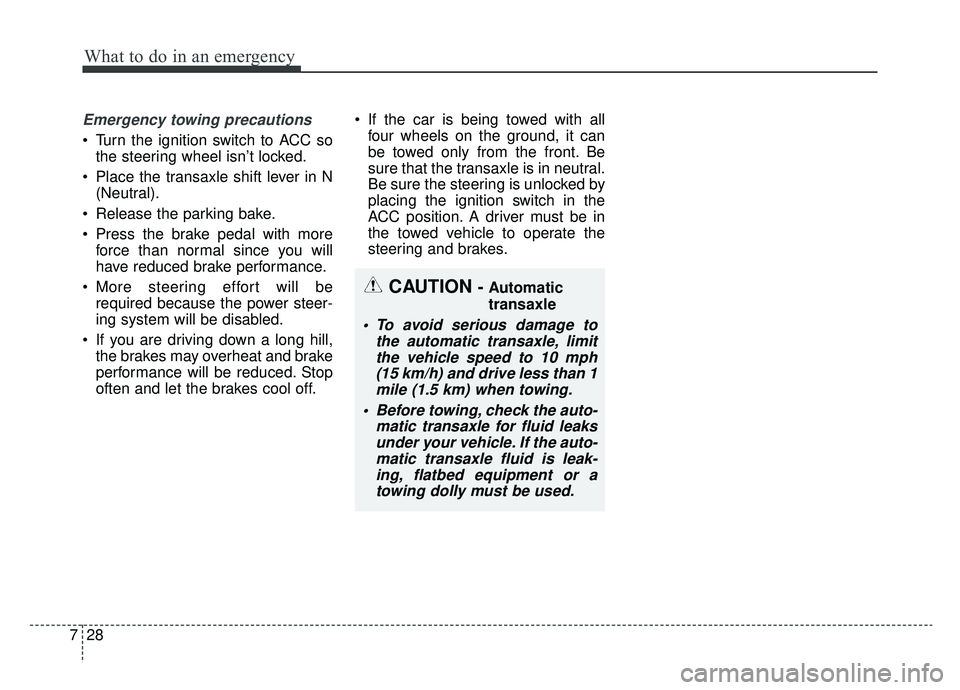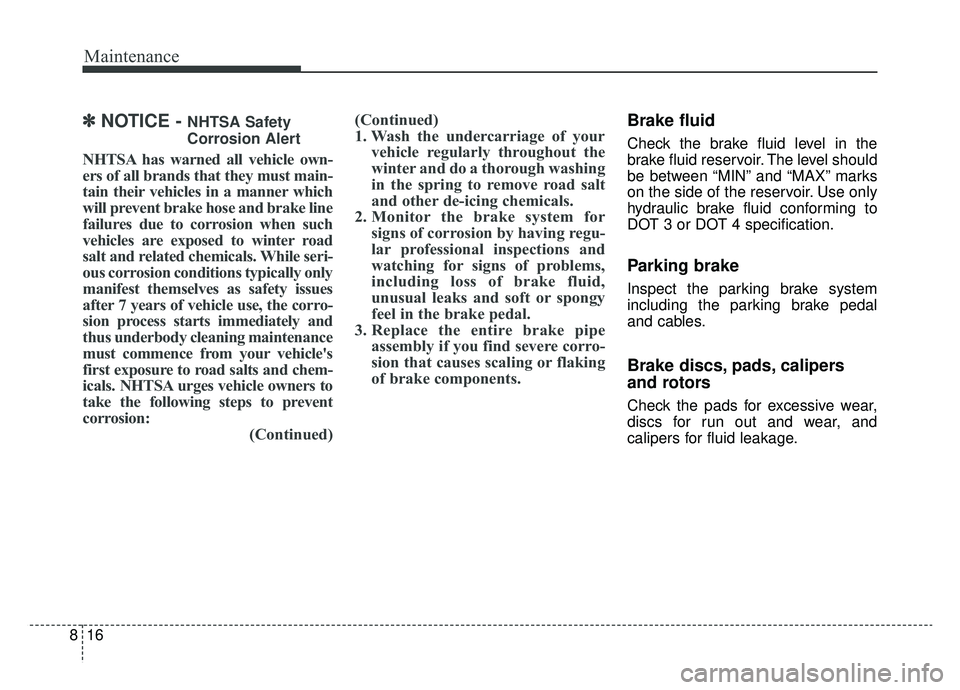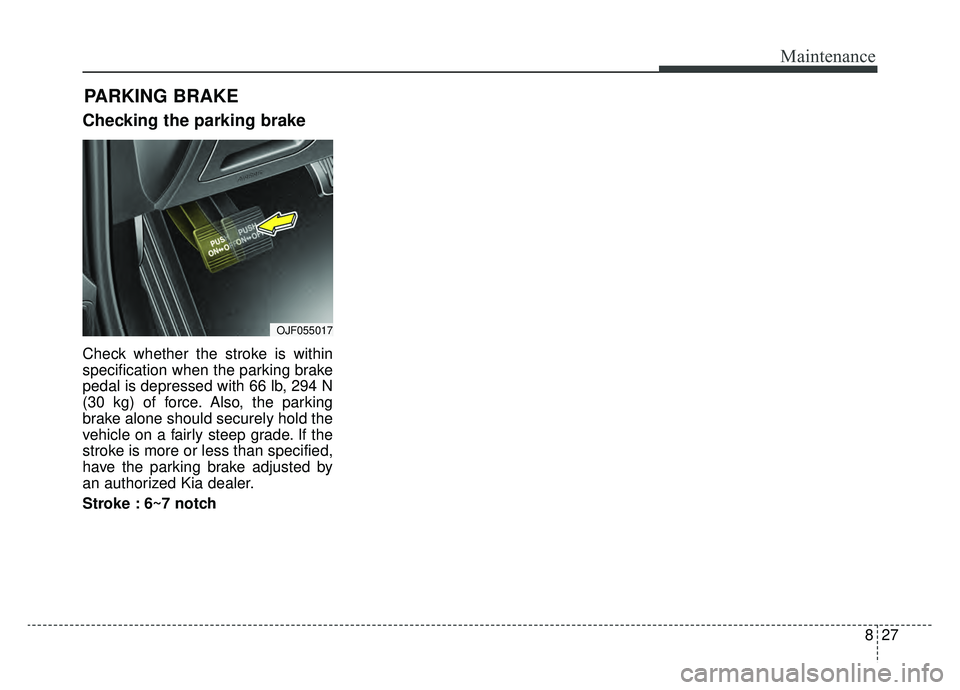2019 KIA OPTIMA HYBRID parking brake
[x] Cancel search: parking brakePage 423 of 553

725
What to do in an emergency
When towing your vehicle in an
emergency without wheel dollies :
1. Set the ignition switch in the ACCposition.
2. Place the transaxle shift lever in N (Neutral).
3. Release the parking brake.Removable towing hook
(if equipped)
1. Open the trunk, and remove the towing hook from the tool case.
2. Remove the hole cover pressing the upper part of the cover on the
bumper.
CAUTION - Towing gear
position
Failure to place the transaxleshift lever in N (Neutral) maycause internal damage to thetransaxle.
CAUTION - Towing
Do not tow the vehicle back- wards with the front wheels onthe ground as this may causedamage to the vehicle.
Do not tow with sling-type equipment. Use wheel lift orflatbed equipment.
HXD02
HXD03
OJFHP066017N
Page 426 of 553

What to do in an emergency
28
7
Emergency towing precautions
Turn the ignition switch to ACC so
the steering wheel isn’t locked.
Place the transaxle shift lever in N (Neutral).
Release the parking bake.
Press the brake pedal with more force than normal since you will
have reduced brake performance.
More steering effort will be required because the power steer-
ing system will be disabled.
If you are driving down a long hill, the brakes may overheat and brake
performance will be reduced. Stop
often and let the brakes cool off. If the car is being towed with all
four wheels on the ground, it can
be towed only from the front. Be
sure that the transaxle is in neutral.
Be sure the steering is unlocked by
placing the ignition switch in the
ACC position. A driver must be in
the towed vehicle to operate the
steering and brakes.
CAUTION - Automatic
transaxle
To avoid serious damage to the automatic transaxle, limitthe vehicle speed to 10 mph(15 km/h) and drive less than 1mile (1.5 km) when towing.
Before towing, check the auto- matic transaxle for fluid leaksunder your vehicle. If the auto-matic transaxle fluid is leak-ing, flatbed equipment or atowing dolly must be used.
Page 428 of 553

Maintenance
Engine compartment . . . . . . . . . . . . . . . . . . . . . . . . 8-3
Maintenance services . . . . . . . . . . . . . . . . . . . . . . . . 8-4
• Owner’s responsibility . . . . . . . . . . . . . . . . . . . . . . . . . 8-4
• Owner maintenance precautions . . . . . . . . . . . . . . . . . 8-5
Owner maintenance . . . . . . . . . . . . . . . . . . . . . . . . . 8-6
• Owner maintenance schedule. . . . . . . . . . . . . . . . . . . . 8-6
Scheduled maintenance service. . . . . . . . . . . . . . . . 8-8
Explanation of scheduled maintenance items . . . 8-14
Checking fluid levels . . . . . . . . . . . . . . . . . . . . . . . 8-17
Engine oil. . . . . . . . . . . . . . . . . . . . . . . . . . . . . . . . . 8-18
• Checking the engine oil level . . . . . . . . . . . . . . . . . . . 8-18
• Changing the engine oil and filter . . . . . . . . . . . . . . . 8-19
Engine maintenance mode (for plug-in Hybrid) . 8-20
• Starting engine maintenance mode . . . . . . . . . . . . . . 8-20
• Stopping engine maintenance mode . . . . . . . . . . . . . 8-20
Coolant . . . . . . . . . . . . . . . . . . . . . . . . . . . . . . . . . . 8-21\
• Checking the coolant level . . . . . . . . . . . . . . . . . . . . . 8-21
• Engine coolant . . . . . . . . . . . . . . . . . . . . . . . . . . . . . . . 8-22
• Inverter coolant . . . . . . . . . . . . . . . . . . . . . . . . . . . . . . 8-22
• Recommended coolant . . . . . . . . . . . . . . . . . . . . . . . . 8-23
• Changing the coolant . . . . . . . . . . . . . . . . . . . . . . . . . 8-24
Brake fluid . . . . . . . . . . . . . . . . . . . . . . . . . . . . . . . 8-25
• Checking the brake fluid level . . . . . . . . . . . . . . . . . . 8-25
Washer fluid . . . . . . . . . . . . . . . . . . . . . . . . . . . . . . 8-26
• Checking the washer fluid level . . . . . . . . . . . . . . . . . 8-26
Parking brake . . . . . . . . . . . . . . . . . . . . . . . . . . . . . 8-27
• Checking the parking brake. . . . . . . . . . . . . . . . . . . . 8-27
Air cleaner. . . . . . . . . . . . . . . . . . . . . . . . . . . . . . . . 8-28
• Filter replacement . . . . . . . . . . . . . . . . . . . . . . . . . . . . 8-28
Climate control air filter . . . . . . . . . . . . . . . . . . . . 8-30
• Filter inspection . . . . . . . . . . . . . . . . . . . . . . . . . . . . . . 8-30
Wiper blades . . . . . . . . . . . . . . . . . . . . . . . . . . . . . . 8-32
• Blade inspection . . . . . . . . . . . . . . . . . . . . . . . . . . . . . . 8-32
• Blade replacement . . . . . . . . . . . . . . . . . . . . . . . . . . . . 8-32
Battery . . . . . . . . . . . . . . . . . . . . . . . . . . . . . . . . . . . 8-\
36
• For best battery service . . . . . . . . . . . . . . . . . . . . . . . 8-36
• Recharging the battery . . . . . . . . . . . . . . . . . . . . . . . . 8-37
• Reset items . . . . . . . . . . . . . . . . . . . . . . . . . . . . . . . . . . 8-38\
Tires and wheels . . . . . . . . . . . . . . . . . . . . . . . . . . . 8-39
• Tire care . . . . . . . . . . . . . . . . . . . . . . . . . . . . . . . . . . . 8-\
39
• Recommended cold tire inflation pressures . . . . . . . 8-39
• Tire pressure . . . . . . . . . . . . . . . . . . . . . . . . . . . . . . . . 8-40
• Checking tire inflation pressure. . . . . . . . . . . . . . . . . 8-40
• Tire rotation . . . . . . . . . . . . . . . . . . . . . . . . . . . . . . . . . 8-41
• Wheel alignment and tire balance . . . . . . . . . . . . . . . 8-42
• Tire replacement . . . . . . . . . . . . . . . . . . . . . . . . . . . . . 8-43
• Wheel replacement . . . . . . . . . . . . . . . . . . . . . . . . . . . 8-43
• Tire traction . . . . . . . . . . . . . . . . . . . . . . . . . . . . . . . . . 8-44
8
Page 433 of 553

Maintenance
68
OWNER MAINTENANCE
The following lists are vehicle checks
and inspections that should be per-
formed by the owner or an author-
ized Kia dealer at the frequencies
indicated to help ensure safe,
dependable operation of your vehi-
cle.
Any adverse conditions should be
brought to the attention of your deal-
er as soon as possible.
These Owner Maintenance Checks
are generally not covered by war-
ranties and you may be charged for
labor, parts and lubricants used.Owner maintenance schedule
When you stop for fuel:
Check the engine oil level.
Check the coolant level in coolantreservoir.
Check the windshield washer fluid level.
Look for low or under-inflated tires.
While operating your vehicle:
Note any changes in the sound of the exhaust or any smell of
exhaust fumes in the vehicle.
Check for vibrations in the steering wheel. Notice any increased steer-
ing effort or looseness in the steer-
ing wheel, or change in its straight-
ahead position.
Notice if your vehicle constantly turns slightly or “pulls” to one side
when traveling on smooth, level
roads.
When stopping, listen and check for unusual sounds, pulling to one
side, increased brake pedal travel
or “hard-to-push” brake pedal.
If any slipping or changes in the operation of your transaxle occurs,
check the transaxle fluid level.
Check the automatic transaxle P (Park) function.
Check the parking brake.
Check for fluid leaks under your vehicle (water dripping from the air
conditioning system during or after
use is normal).
WARNING- Hot coolant
Be careful when checking your
engine coolant level when the
engine is hot. Scalding hot
coolant and steam may blow
out under pressure.
WARNING
When you open the engine
hood, turn the Hybrid system
off. If not, it may result in death
or serious injury because of the
high voltage flow.
Page 438 of 553

811
Maintenance
Number of months or driving distance, whichever comes first
Months1224364860728496108120132144156168180
Miles×1,0007.51522.530 37.5 45 52.5 60 67.5 75 82.5 90 97.5 105 112.5
Km×1,00012 24 36 48 60 72 84 96 108 120 132 144 156 168 180
Fuel tank air filter *3-I-I-I-I-I-I-I-
Fuel lines, hoses and connections---I---I---I---
Parking brake (Foot Type)-I-I-I-I-I-I-I-
Brake fluid-I-I-I-I-I-I-I-
MAINTENANCEINTERVALS
MAINTENANCE
ITEM
Normal Maintenance Schedule - Non Turbo Model (CONT.)
I : Inspect and if necessary, adjust, correct, clean or replace.
R : Replace or change.
*
3: Fuel tank air filter are considered to generally be maintenance free but periodic inspection is recommended under this main- tenance schedule depending on fuel quality.
Page 439 of 553

Maintenance
12
8
Maintenance Under Severe Usage Conditions - Non Turbo Model
The following items must be serviced more frequently on cars normally used under severe driving conditions. Refer
to the chart below for the appropriate maintenance intervals.
R : Replace I : Inspect and, after inspection, clean, adjust, repair or replace if neces\
sary
MAINTENANCE ITEMMAINTENANCE
OPERATIONMAINTENANCE INTERVALSDRIVING
CONDITION
Engine oil and engine oil filterNu 2.0L GDIREvery 3,750 miles (6,000 km) or 6 monthsA, B, C, D, E,
F, G, H, I, J, K
Air cleaner filterRMore frequentlyC, E
Spark plugs RMore frequentlyA, B, F, G, H, I, K
Automatic transmission fluidREvery 60,000 miles (96,000 km)A, C, D, E,
F, G, H, I, J
HSG (Hybrid Starter & Generator) belt
REvery 30,000 miles (48,000 km) or 24 monthsC, D, E, K
IEvery 3,750 miles (6,000 km) or 6 monthsC, D, E, K
Brake discs and pads, calipers and rotorsIMore frequentlyC, D, E, G, H
Parking brake (Foot Type)IMore frequentlyC, D, G, H
Steering gear rack, linkage and bootsIMore frequentlyC, D, E, F, G
Suspension ball jointsIMore frequentlyC, D, E, F, G
Page 443 of 553

Maintenance
16
8
✽ ✽
NOTICE - NHTSA Safety
Corrosion Alert
NHTSA has warned all vehicle own-
ers of all brands that they must main-
tain their vehicles in a manner which
will prevent brake hose and brake line
failures due to corrosion when such
vehicles are exposed to winter road
salt and related chemicals. While seri-
ous corrosion conditions typically only
manifest themselves as safety issues
after 7 years of vehicle use, the corro-
sion process starts immediately and
thus underbody cleaning maintenance
must commence from your vehicle's
first exposure to road salts and chem-
icals. NHTSA urges vehicle owners to
take the following steps to prevent
corrosion:
(Continued)(Continued)
1. Wash the undercarriage of your
vehicle regularly throughout the
winter and do a thorough washing
in the spring to remove road salt
and other de-icing chemicals.
2. Monitor the brake system for signs of corrosion by having regu-
lar professional inspections and
watching for signs of problems,
including loss of brake fluid,
unusual leaks and soft or spongy
feel in the brake pedal.
3. Replace the entire brake pipe assembly if you find severe corro-
sion that causes scaling or flaking
of brake components.
Brake fluid
Check the brake fluid level in the
brake fluid reservoir. The level should
be between “MIN” and “MAX” marks
on the side of the reservoir. Use only
hydraulic brake fluid conforming to
DOT 3 or DOT 4 specification.
Parking brake
Inspect the parking brake system
including the parking brake pedal
and cables.
Brake discs, pads, calipers
and rotors
Check the pads for excessive wear,
discs for run out and wear, and
calipers for fluid leakage.
Page 454 of 553

827
Maintenance
Checking the parking brake
Check whether the stroke is within
specification when the parking brake
pedal is depressed with 66 lb, 294 N
(30 kg) of force. Also, the parking
brake alone should securely hold the
vehicle on a fairly steep grade. If the
stroke is more or less than specified,
have the parking brake adjusted by
an authorized Kia dealer.
Stroke : 6~7 notch
PARKING BRAKE
OJF055017